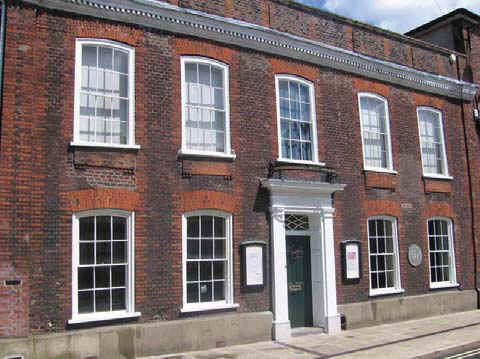


Gainsborough's House is the birthplace of the leading English painter Thomas Gainsborough. It is now a museum and gallery, located at 46 Gainsborough Street in Sudbury, Suffolk, England.
Thomas Gainsborough (1727-88) was born in Sudbury and baptised at the Independent Meeting-House in Friars Street on 14 May 1727, the fifth son and ninth child of John and Mary Gainsborough. In 1958, Gainsborough’s House Society was formed to purchase the house and establish it as a centre for Thomas Gainsborough. The Museum opened to the public in 1961 and has remained open for over 50 years. The beautiful historic garden at the heart of Gainsborough’s House is maintained by a devoted body of volunteers, who garden exclusively with plants that were available in Gainsborough’s lifetime.
Galleries
After an introduction to Gainsborough at Gainsborough’s House, visitors enter two downstairs rooms, the Entrance Hall and the Parlour, which explore the achievements of the artist and his time in Suffolk. The Entrance Hall displays some of the highlights from the collection including Gainsborough’s Pitminster Boy, alongside a collection of Gainsborough’s belongings including his swordstick, paint scraper and his studio cabinet. The Parlour displays paintings and drawings alongside period furniture.
The hall and stairs are filled with portraits of the Gainsborough family and works by Gainsborough Dupont, the great artist’s nephew, apprentice and studio assistant.
The two rooms upstairs consider in turn ‘The curs’d face business,’ the portraits of Thomas Gainsborough and ‘Nature was his teacher,’ the landscapes of the artist. The Study Gallery, once a weaving room, explores the art of printmaking, while the third floor is given over to changing displays, focusing on significant aspects of Gainsborough’s achievements as an artist.
Garden
The garden is deceptively larger than the first glimpse suggests. Its centre piece is the huge mulberry tree, dating to the early 1600s during the reign of James I, who encouraged the planting of mulberry trees with the idea of establishing a silk producing industry.
The Gainsborough’s House mulberry tree is spectacular with its spreading, giant boughs now propped by tree stumps still produce a fine crop of fruit. The silkworm breeding industry did not take-off, thanks in part to the lack of botanical knowledge of the King and his advisers. There are two kinds of mulberry tree – the white, which feeds silkworms, and the black, which supplies fruit. It is the black mulberry tree that was cultivated in England, in estates and substantial gardens throughout the country.
An off-shoot of the silk weaving craft, 400 years later, is that Sudbury is the biggest exporter of silk goods in England. Vanners Silk Weavers, who back on to Gainsborough’s House garden, has been producing silk since 1740. They have produced the silk for several Royal Weddings and work with some of the leading textile designers in the world.
Head gardener Jane Lowe leads a team of dedicated volunteer gardeners who ensure that the garden is maintained all year round. There are two herb beds and another is devoted to plants traditionally used for dyeing fabric. The remaining beds and borders are planted with shrubs, perennials, bulbs and annuals using plants that were available in Gainsborough’s lifetime. Plants and seeds from the garden are for sale to raise funds towards the upkeep of the garden.
Information for Visitors with Access Needs
Gainsborough’s House is entered via the shop entrance at ground level. The exhibition gallery on the ground floor has one step, for which a temporary ramp is available.
The house has three floors. The second floor is accessible via a platform lift. The upper floor is only accessible via a flight of seven curved stairs.
There is an accessible toilet next to the shop.
The garden is partly accessible with a ramp to the higher level. There are some uneven paths and grass surfaces.
Although we do not have a car park, a parking space close to the house can usually be made available for visitors with access needs upon prior arrangement.
The nearest Blue Badge parking spaces are off street bays on Gainsborough Street adjacent to Gainsborough’s House. These are limited to one hour waiting.

